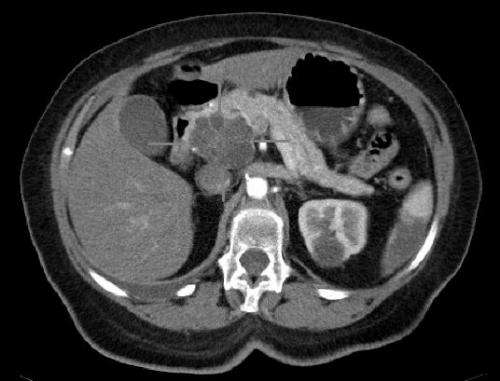This article has been reviewed according to Science X's editorial process and policies. Editors have highlighted the following attributes while ensuring the content's credibility:
fact-checked
peer-reviewed publication
proofread
Pancreatic cancer risk lower if pancreatic cysts remain stable for five years: Study

Low-risk branch duct intraductal papillary mucinous neoplasms (IPMN) are the most common precancerous form of mucinous pancreatic cysts and once identified require regular surveillance imaging. But consensus is still forming around how long that watchful period should last.
In a new study, Yale Cancer Center researchers at Yale School of Medicine question the health benefit of extended surveillance for patients whose cyst has not changed size for at least five years and had no worrisome features. The study was published in the June 2023 edition of Clinical Gastroenterology and Hepatology.
"Pancreatic cysts are extremely common and often require regular imaging surveillance due to their variable risk of pancreatic cancer," said senior author Dr. James Farrell, professor of medicine and surgery at Yale School of Medicine and director of the Yale Center for Pancreatic Diseases. "Controversy exists with current guidelines about which patients should consider stopping surveillance. This current study highlights the persistent risk of malignancy even after five or 10 years of surveillance."
In a systematic review of 41 IPMN surveillance studies, researchers compared the incidence of worrisome features and high-risk stigmata (WF/HRS) as well as advanced neoplasia (including pancreatic cancer) during the initial surveillance period (during the first five years after initial observation) and extended surveillance period (after five years).
Researchers found the risk of WF/HRS rose from 2.2% in initial surveillance to 2.9% patient-years in extended surveillance, while the risk of advanced neoplasia rose from 0.6% to 1.0% patient-years between the initial and extended periods. However, among patients whose cyst had five years of size stability, extended surveillance showed a lower 1.9% patient-years risk of WF/HRS, and a 0.2% patient-years risk of advanced neoplasia.
In certain patients for whom cyst size remained stable for five years or more, extended surveillance may not offer a worthwhile survival benefit, but more high-quality studies are needed before surveillance cessation can be recommended, researchers said.
"A greater understanding of the biology and natural history of progression of pancreatic cysts is needed to improve our surveillance strategies, in order to make more informed decisions about which patients to follow more closely, and about which patients we can decrease surveillance," said Farrell.
More information: Ankit Chhoda et al, Benefit of Extended Surveillance of Low-Risk Pancreatic Cysts After 5-Year Stability: A Systematic Review and Meta-Analysis, Clinical Gastroenterology and Hepatology (2022). DOI: 10.1016/j.cgh.2022.04.025



















